A draw is the most sought-after ball flight in the amateur game. Every golfer wants to know how to hit a draw in golf.
Golfers stuck with the dreaded slice stand in awe and envy when a golfing partner hits a high draw soaring through the air, and with a slight curve, returns to the safety of the fairway and then rolls out for miles.
Want to know how to hit a draw in golf? Make sure you aim to the right of your target line, stick to your refined swing, work from a stable base, flatten your golf swing, shift your weight, close your clubface, and swing with an in-to-out path. That will certainly help you in learning to hit a draw in golf.
For many beginners and high-handicap golfers, a draw is what they dream of but lack the confidence that they, too, can attain the heights of hitting a draw with a driver off the tee. More experienced golfers lack the consistency to be able to draw the ball at will.
What Is a Draw Swing in Golf?
A draw starts with a ball flight away from your body towards the edge of the fairway on the side you were looking toward at the address and slowly curves back towards the middle of the fairway. Once it lands, unless the fairway is extremely soft or waterlogged, the ball will roll out for several yards.
The curve of a draw is generally around fifteen yards from the outer edge of the curve to the landing zone.
Compared to a fade, you can expect to gain between 5 and 10 yards with a draw, and it is a shot that moves left to right instead of right to left.
Read Next: How To Hit A Fade
How To Hit a Draw in Golf
If a consistent draw golf shot eludes you, then you’re in a common spot.
You might crush the ball off the tee, starting it fifteen yards or so out to the right, and wait for it to swing back into the middle of the fairway.
But the movement never comes.
I experienced this a few times, and one particular instance that stands out in my mind is when I played at the Gary Player Country Club in South Africa.
Standing on the 18th tee, I wanted to draw the ball to land closer to the water for a shorter approach shot. I let rip with the driver towards the right edge of the fairway wanting to draw it back to the middle or left side of the fairway.
The ball just carried on straight right until the caddy, in pure desperation, shouted at the ball, ‘Come Back, All is Forgiven!’
The lack of a draw on command is not due to a lack of ability.
Some equipment has a fade bias, making it extremely difficult to hit that soaring draw you want. So your equipment might be holding you back.
Your understanding of what is required to hit a draw may have been clouded by the many articles and videos you have absorbed on the subject.
In your interest, it is necessary to have an open mind and follow the steps in this article without thinking about other instructions that you have encountered.
Read More: How To Aim In Golf
Step-by-Step Guide: Drawing Your Golf Swing Consistently
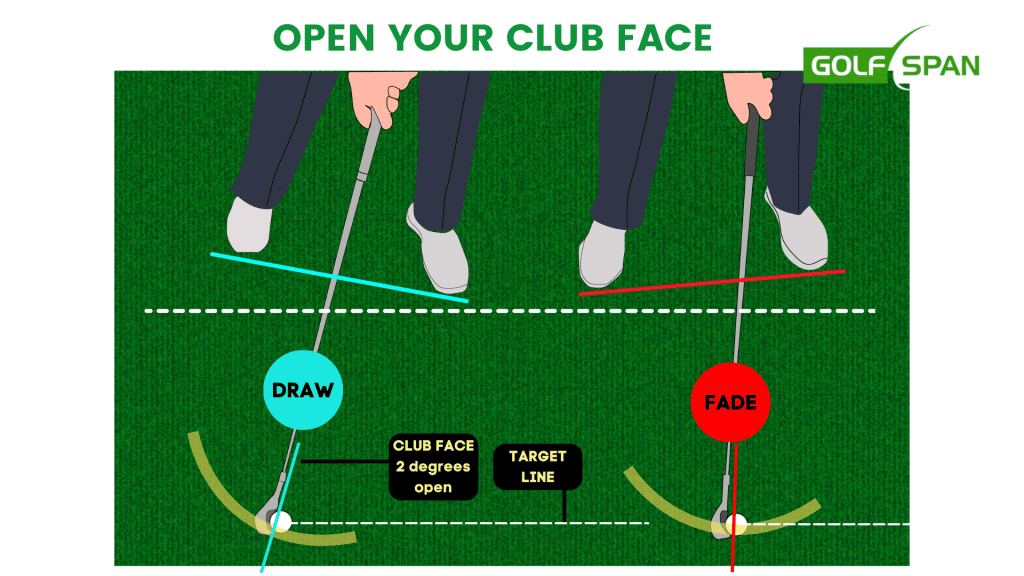
1. Set up Your Ball Properly
For the proper setup position, the golf ball must be teed up in line with the instep of your leading foot in the correct position.
It is ideal to impact the golf ball on the upswing of your driver. The tee height will determine whether your swing is shallow or steep.
2. Open Your Club Face
As mentioned earlier, the clubhead’s position at impact plays a determining role in the direction of the ball flight after impact.
Find your landing area target, and point your clubface right of the target to produce a draw in an in-to-out path.
3. Aim Your Body To The Right
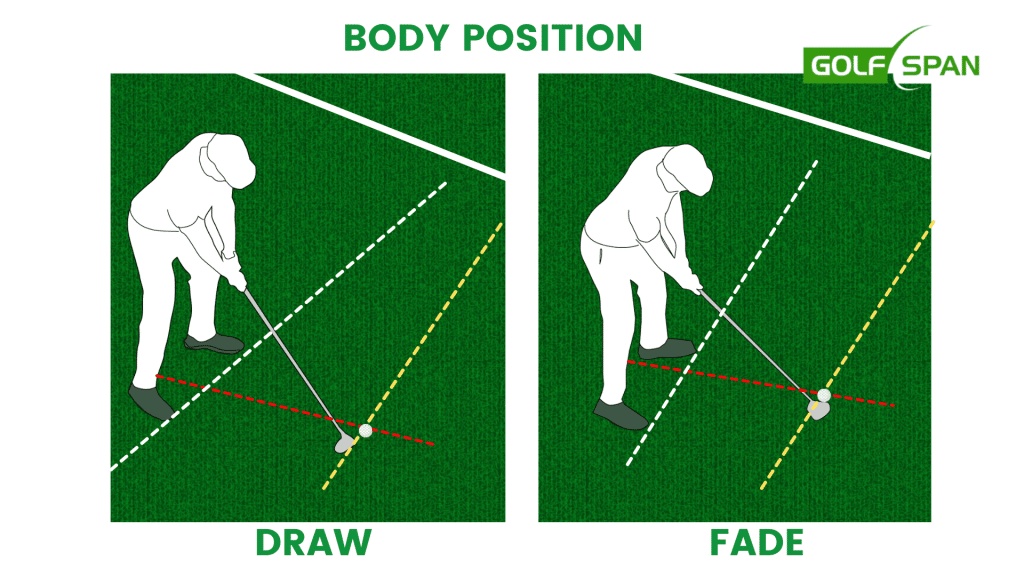
This will, in effect, close the clubface about the swing path, thus generating spin toward the outside of the ball, creating a draw.
You can drop your right foot back an inch or two at the address to exaggerate the inside-out swing path.
4. Shallow Your Swing
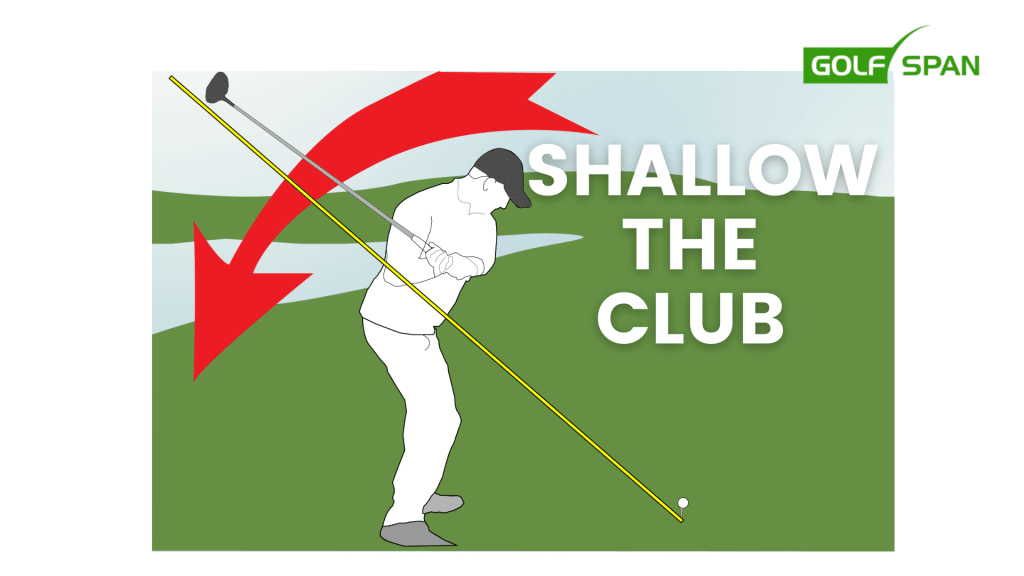
Just remember that the clubface is the biggest factor in the direction that the ball starts. However, the draw swing path determines the curve on the ball.
This implies that an open clubface will direct the ball to the direction required for hitting a draw, depending on your trailing hand.
When focusing on a draw in your golf swing, the swing path will determine the amount of curve that you generate. Your swing path must be outside the direction the clubface is pointing.
You should not make wholesale changes to your swing when hitting a draw in golf.
The swing you have built is sufficient. The alignment of your body and the clubface will be the factors that generate the draw ball flight. Shallow out your driver’s swing.
An error that occurs during the swing, especially with the driver, is that golfers take it back too steep and cannot flatten it during the downswing.
This results in a steep downswing making it extremely difficult to generate the inside-out swing path required for a draw.
5. Rotate Your Upper Body on Backswing
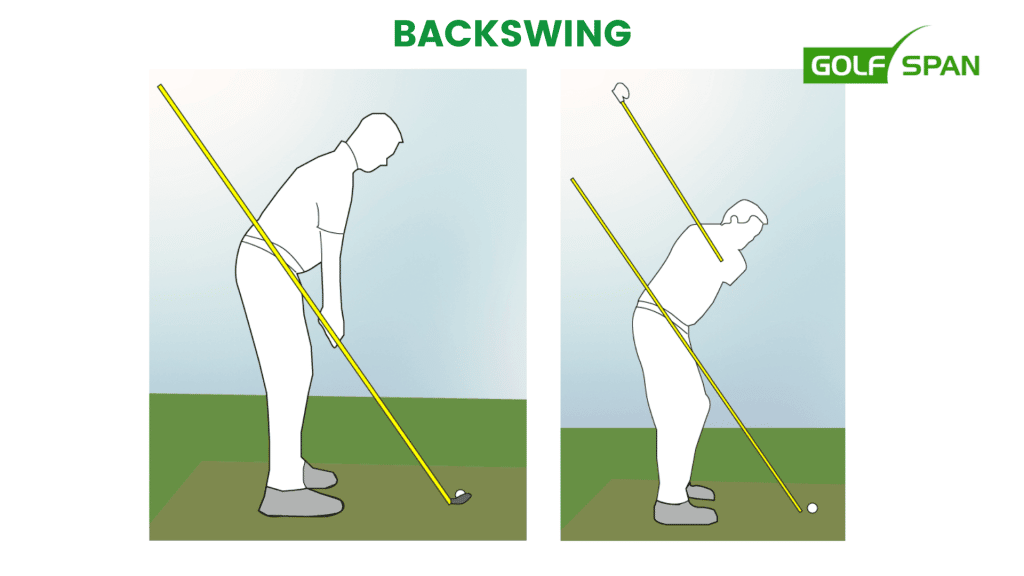
Initiate the backswing with your upper body, not your arms. Rotate your upper body, pushing your trailing hip back and upwards. Do not sway toward the trailing side.
The rotation of the upper body will push your leading shoulder back, tucking it in under your chin. This will furthermore assist in creating a flatter backswing and prevent an over-the-top or outside-in swing.
Beware of opening the clubface at this stage since you require a closed club face to hit a draw.
6. Shift Your Weight To Transition
A critical part of the transition process is the weight shift, not sway.
Lack of weight shift to your leading side will result in your body hanging back and creating a weak shot. Moreover, this will produce a more open clubface at impact, negating the alignment process.
7. Push Hips Slightly Forward on Downswing
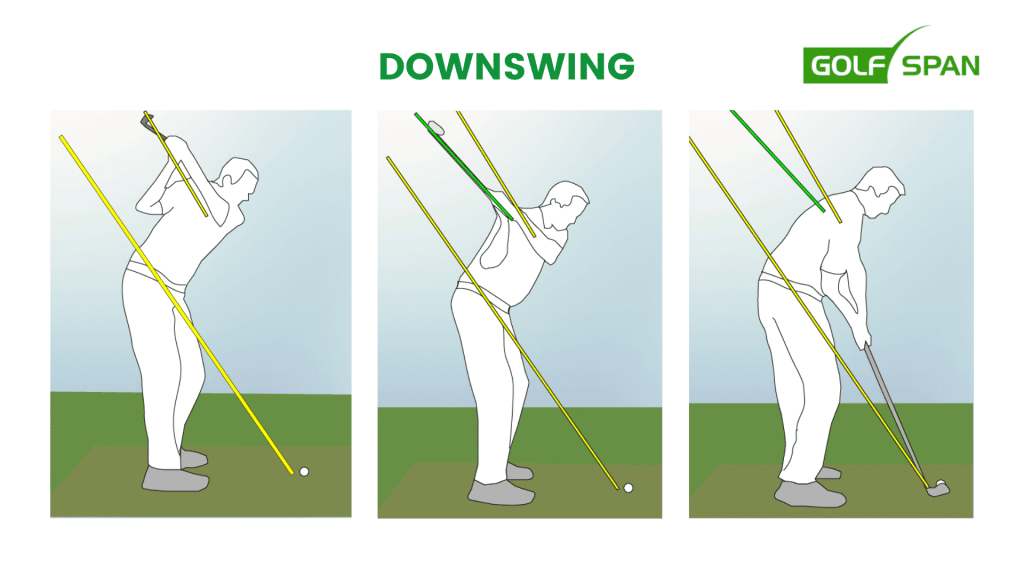
The downswing is initiated by the lower body pushing your hips slightly forward without swaying, transferring your weight to your leading leg, and rotating your hips.
Keep your shoulders back as long as possible to prevent the upper body from spinning toward the target and shifting to the back foot.
8. Impact
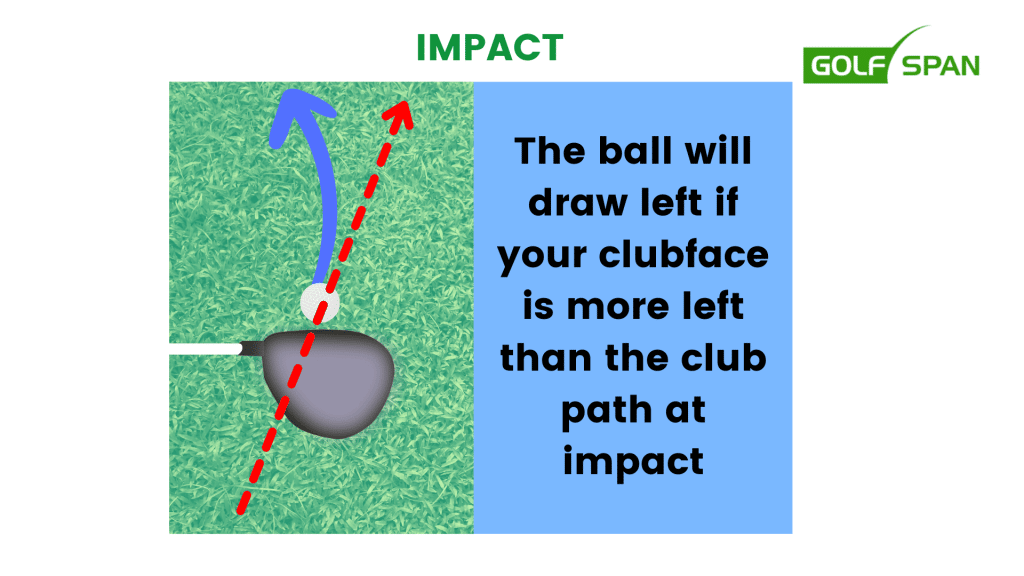
Minimize forearm rotation through impact as excessive forearm rotation toward the target creates a closed club face prior to impact.
The key factor for starting the ball in the right direction is that the clubface points to the right at impact.
9. Release
You do not stop the swing at impact. You need the momentum to release your club and complete the swing. Keep your arms fully extended after impact until approximately 45 degrees in front of your body for the ideal golf draw.
The swing will pull your body around your spine and finish with your chest facing slightly upwards and towards the target. Also, feel like your arms just swung around your body, and the club didn’t stop moving until it lost all its momentum.
Finishing strong is a terrific way to ensure that all the preparation and build-up culminates in a strong, proud, and balanced finish.
Want To Learn Other Golf Shots? Here’s a Guide To The Different Types of Golf Shots
Hitting a Draw With Driver vs How To Hit a Draw With Irons
When looking at a draw with a driver compared to an iron, there are not many differences – the principles remain the same.
If you’re using a driver, you will focus on the club face being closed slightly, your aim out right with an in-to-out swing pattern, and your ball position to hit a draw with a driver.
When thinking about how to hit a draw with an iron, the club face must be closed slightly, and the club must head towards the right if the golfer is right-handed.
Obviously, the club face is smaller than a driver, so it can be harder to get the ideal draw as readily as you can with a driver. However, the steps to ensuring the best possible chance of a draw are the same, so apply the same principles, and you are on the right path.
Practicing a Draw Shot With a Training Aid
A training aid that a draw shot can be practiced with is the Garmin R10 Approach. You can use the driving range simulator to access a top-down dispersion map of your draws, checking the distances for draws with different clubs and the average carry distances for each club.
This will allow you to see which of your clubs suit the draw the best, how the shot plays out in person, and which clubs work for you.
You could then put the draw practice to the test on Play on Home Tee Hero, a subscription service that allows you to access 42,000 courses on the app.
Bonus Tips When Learning How To Hit a Draw With a Driver
Swing Smooth Like Normal
Keep to your normal swing and keep the tempo going. There is no need to swing faster or rush the swing. Your normal swing speed, tempo, and path are all you need.
The ball’s direction is managed by the clubhead angle and your body alignment.
Trying to change factors that need no adjustment will cause loads of frustration when assessing the reasons for not hitting a draw.
Clubhead Position vs Swing Path
When looking at how to draw a golf ball, originally, the prevalent belief was that your swing path at impact determines the golf ball’s path. This has changed since the launch of golf launch monitors.
Research has shown that the position of the clubface at impact determines the ball’s path while the swing path determines the amount of curve.
Use a Neutral Grip
As with all clubs, the neutral grip is the preferred grip for shaping your shots. A weak grip will leave the clubface too open, while a strong grip creates a closed club face.
The stronger grip will assist you in hitting a draw but make it more difficult to control the curve.
Read More: How To Grip A Golf Club
Visualize a Draw
The mental aspect of golf is highly underrated by amateur golfers. Professional golfers visualize their shots and the shape they want to achieve. This relates to all aspects of the game, including putting.
Part of your pre-shot routine includes swinging your club to ‘feel’ the shot. Make sure it isn’t a straight shot, though! This is a perfect time to visualize the ball flying on the path that you have in mind. This will create the confidence that you can execute the draw successfully.
Please watch this YouTube video for more information on hitting a draw
Final Thoughts on How To Hit a Draw Golf Shot
Hitting a draw is high on the priority list of many golfers, and they frequently try without much success. This is not due to the lack of ability, but rather the lack of understanding of the steps required.
The amount of instruction available on the internet can be extremely confusing and hamper your progress.
The process of learning how to hit a draw golf shot sounds like a lot to remember, but it’s not much different from what you would normally do, except for the closed club face and body alignment.
Work on squaring the face to the target through impact, not in the direction of your swing. This will support the in-to-out path. Practice makes perfect when learning how to hit a draw in golf.
Happy swinging and drawing!
FAQs
Why Is It So Hard To Hit a Draw?
A draw in golf can be so hard to hit, even when you are a very competent golfer, for many reasons. One of those reasons is that so many factors can be considered and applied correctly.
Where Do You Aim When Hitting a Draw?
If you are right-handed, aim your feet, hips, and shoulders further to the right than the clubface. This will enable you to close the clubface about the swing path of the ball. Spin will then be generated toward the outside of the golf ball, creating the draw shot.
How Do You Consistently Hit a Draw in Golf?
You will need lots of practice to consistently hit a great draw in golf. Plenty of us hit a nice draw occasionally, but if you wonder, how do you hit a draw in golf whenever needed, you must apply all the principles, and the key is to aim to the right of your target line and focus on your swing.
Related Articles
Nick is the founder of GolfSpan and an avid golfer. He's not quite a pro but has over 15 years of experience playing and coaching golfers worldwide. His mission is to bring the golfing community a better experience when it comes to choosing the right golf gear and finding the right setup for your game.






